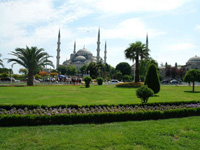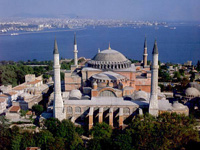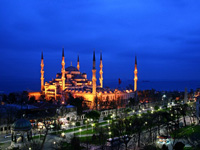
The area covered by Sultanahmet, is the oldest and longest inhabited part of contemporary Istanbul. This is the area where the Byzantine capital, Constantinople was located at the southern bank of the Golden Horn and parts of the defence wall of the old city are still remaining along the coast.
The Ottoman Sultan, Mehmet Fatih II set as the ultimate goal of his reign to conquer the city, which he finally succeeded in 1453 after a long siege. It is indicative that the fall of Constantinople signifies the collapse of the Byzantine Empire, even though all of its territory had been conquered by the Ottomans almost a century ago. Right after the capture of the city, Sultan Mehmet Fatih II, transferred there the capital of the Ottoman Empire, from Bursa.

In the Ottoman Period the city became the administrative centre of the Empire and in the following centuries it witnessed further development and economic growth. The most important palaces and administrative buildings of the Ottoman Empire, such as the courts of justice, were located in the area. Some of them are still used by the government, accommodating some of the most important public services and ministry offices.
Due to the history and cultural past of the area, the most important sites of Istanbul are located in Sultanahmet;
Ayasofya Müzesi (Hagia Sophia Museum) is an impressive piece of architectural art. Since 537 AC when it was built as an Orthodox Church, during the reign of Justinian, Emperor of the Byzantine Empire, it was the symbol of Constantinople. It was turned into a Mosque in 1453, when the city was conquered by Sultan Mehmet Fatih II and after 1923 and the foundation of the Turkish Republic it has been turned into a Museum.

Sultanahmet Camii (The Blue Mosque) is located opposite to Ayasofya and it is one of the most historical mosques in Istanbul. It was built in 1616 by Sultan Mehmed I and it has taken its name from the blue tiles that decorate its walls. It’s interior is very impressive and even though it is used as place of worship, many tourists have the opportunity to visit it on a daily basis. It is the biggest mosque in the city, with the unique attribute of comprising six minarets, while the vast majority of mosques around the world have one to four minarets.
Topkapı Sarayı (Topkapi Palace). It has been the central palace and the main residence of the Sultan in the Ottoman Empire between 1465 and 1856. It comprises four courtyards and numerous rooms, including the Imperial Carriages, the Palace Kitchen, the Imperial Council, the Tower of Justice, the Arms Collection, the Audience Chamber, the Harem, the Sanctuary of Holy Relics and many more. Topkapi Palace is an enormous arrangement of different buildings, so you will need about two hours in order to see all of them. So make sure you have enough time when you visit it.
 The area covered by Sultanahmet, is the oldest and longest inhabited part of contemporary Istanbul. This is the area where the Byzantine capital, Constantinople was located at the southern bank of the Golden Horn and parts of the defence wall of the old city are still remaining along the coast.
The area covered by Sultanahmet, is the oldest and longest inhabited part of contemporary Istanbul. This is the area where the Byzantine capital, Constantinople was located at the southern bank of the Golden Horn and parts of the defence wall of the old city are still remaining along the coast. In the Ottoman Period the city became the administrative centre of the Empire and in the following centuries it witnessed further development and economic growth. The most important palaces and administrative buildings of the Ottoman Empire, such as the courts of justice, were located in the area. Some of them are still used by the government, accommodating some of the most important public services and ministry offices.
In the Ottoman Period the city became the administrative centre of the Empire and in the following centuries it witnessed further development and economic growth. The most important palaces and administrative buildings of the Ottoman Empire, such as the courts of justice, were located in the area. Some of them are still used by the government, accommodating some of the most important public services and ministry offices. Sultanahmet Camii (The Blue Mosque) is located opposite to Ayasofya and it is one of the most historical mosques in Istanbul. It was built in 1616 by Sultan Mehmed I and it has taken its name from the blue tiles that decorate its walls. It’s interior is very impressive and even though it is used as place of worship, many tourists have the opportunity to visit it on a daily basis. It is the biggest mosque in the city, with the unique attribute of comprising six minarets, while the vast majority of mosques around the world have one to four minarets.
Sultanahmet Camii (The Blue Mosque) is located opposite to Ayasofya and it is one of the most historical mosques in Istanbul. It was built in 1616 by Sultan Mehmed I and it has taken its name from the blue tiles that decorate its walls. It’s interior is very impressive and even though it is used as place of worship, many tourists have the opportunity to visit it on a daily basis. It is the biggest mosque in the city, with the unique attribute of comprising six minarets, while the vast majority of mosques around the world have one to four minarets.